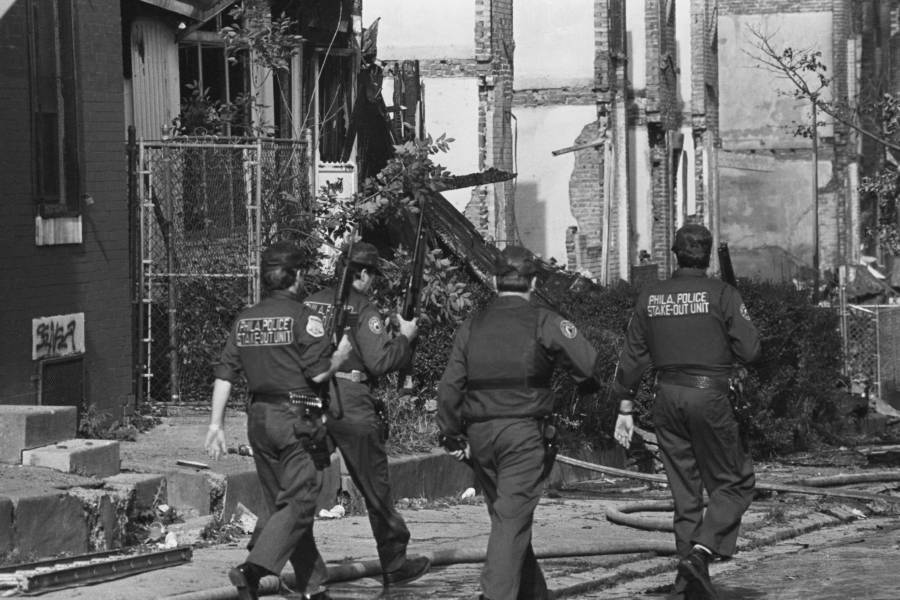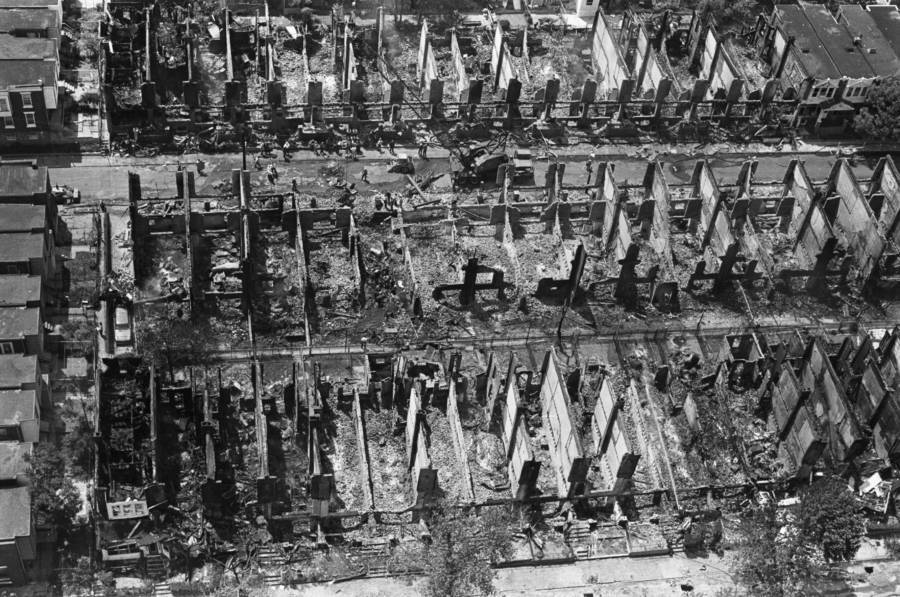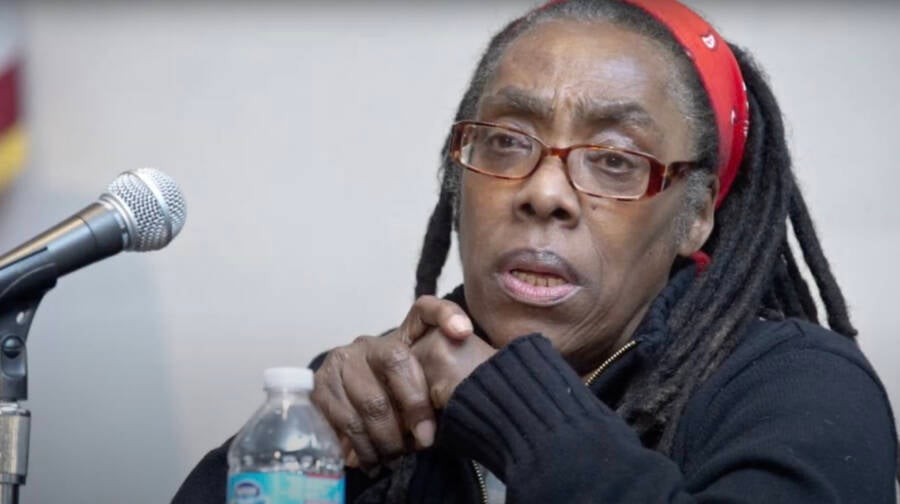On May 13, 1985, Ramona Africa was the only adult to survive the police bombing of the Philadelphia activist group MOVE — only to be thrown in jail afterward.

MOVERamona Africa being escorted out of court in 1986 after being brought up on riot charges stemming from the MOVE bombing that would put her in prison for seven years.
For as long as she could remember, Ramona Africa wanted to be a lawyer. As a child growing up in Philadelphia, her single mother taught her the importance of rising through the socioeconomic ranks, but Africa’s experiences with racism as a young adult ultimately led her down a more revolutionary path.
In 1979, as a pre-law student at Temple University, she was arrested for demonstrating against unjust housing policies. Following this arrest, she became a member of MOVE, a Philadelphia-based Black liberation group that attended her hearing. Inspired by founder John Africa’s preaching against police brutality, oppression, and war, she pledged herself to this growing movement.
But six years after Ramona Africa joined the movement, John Africa and 10 of its members — including five children — were killed by the Philadelphia Police Department in a devastating attack on the group’s home.
Now, as the only living survivor of the 1985 MOVE bombing, she has remained steadfast in her activism and continues to stand against injustice to this day, even as she fights a personal battle against lymphoma.
The Roots Of Ramona Africa’s Activism
The woman who would become known as Ramona Africa was born on June 8, 1955, in Philadelphia, Pennsylvania.
Raised by a devoutly Catholic mother in a middle-class home, she went to parochial school all through to high school. But it was at Philadelphia’s Our Lady of Lourdes that Africa experienced her first racist encounters — incidents that sowed the seeds of her suspicion of governmental systems and educational institutions.
In one formative instance, she saw white students allowed to use the restroom whenever they liked while her requests for a break were denied.
“I didn’t have a militant bone in my body then,” she told Inside the Activist Studio. “I really didn’t, but something clicked when [I was told] ‘no.'”
As her mission of fighting injustice spilled out of the classroom, Africa began joining local demonstrations and networking with local activists. She attended her first MOVE meeting on May 20, 1977. But despite the group’s anti-corporation, pro-environment ideas, she had her doubts.
“I remember hearing about different people like Malcolm X, Robert Williams and they fascinated me,” she said. “I ended up reading books about them. The problem is, I read about them and I was in accord with them, but it wasn’t really real to me. It was something I read about.”
Her passion for equal rights took her to Temple University during a time where only five percent of Black people nationwide attended college. While majoring in pre-law, she increasingly obtained hands-on experience.
But a 1979 arrest during a housing protest at Philadelphia City Council led her back to MOVE. She was invited to attend their meetings at her own court hearing — to which she agreed, and ultimately became a regular.
The year before she became a regular, MOVE’s notorious 15-month standoff with police resulted in the incarceration of nine MOVE members. With her new family, Africa attended their hearings.
“That was a wakeup call for me, an eye-opener,” she said, “because nothing that I was taught by those professors at Temple University, nothing I read in those textbooks that I was made to read at Temple University — none of that was happening in those courtrooms.”

The Encyclopedia of Greater PhiladelphiaMayor Wilson Goode ordered the 1985 MOVE evictions that culminated in tragedy.
But the passion she showed from the courtroom galley resulted in Judge Lynn Abraham finding her in contempt of court, and sentencing her to 60 days in jail. This sentence only brought her closer to MOVE — and upon her release from jail, she became a dedicated member.
“I believe that John Africa and his revolution plucked me out of the system at the right time,” she recalled. “Right before I would’ve gone into really being a lawyer.”
The MOVE Bombing Of 1985
Like many West Philadelphians, Ramona Africa still refers to the 1985 MOVE bombing simply by its date. While she’d been arrested and had seen flagrant police brutality before, the date of the bombing — May 13, 1985 — proved to be more terrifying than anything she’d ever experienced.
As the first Black mayor of Philadelphia, Wilson Goode was in a tough spot. His constituents pleaded with him to forcefully order MOVE’s eviction from their Powelton headquarters. Noise complaints and reports of trash littering the property, as well as aggressive encounters with activists, had stacked up.

Bettman/Getty ImagesPolice patrol near 6221 Osage Avenue after firing 10,000 rounds at MOVE’s headquarters and setting the neighborhood ablaze.
Just one day before the bombing, the government began its door-to-door evictions. Many in the middle-class neighborhood complied, but MOVE members remained steadfast in their rights to stay inside. Ramona Africa was one of the many activists living at 6221 Osage Avenue at the time — but she’d be the only adult in the rowhouse to survive.
After a hail of bullets and a deluge of weaponry were unloaded, weapons of war were deployed. Mayor Goode’s eviction order at first mirrored MOVE’s 1978 standoff with police, but its end result was a tragedy of epic proportions.
The Philadelphia Police Department released a satchel bomb infused with C4 and Tovex explosives from the sky via a helicopter. Meanwhile, the streets were flooded with nearly 500 militarized police officers — who were armed with flak jackets, tear gas, and an anti-tank gun.

Bettman/Getty ImagesThe chilling aftermath of the 1985 MOVE bombing.
“Attention, MOVE,” police commissioner Gregore Sambor said through a megaphone. “This is America. You have to abide by the laws of the United States.”
Meanwhile, MOVE members were listening to the events on the radio. Ramona Africa vividly remembers realizing what was about to happen — moments before 10,000 rounds of ammunition were fired at the compound and a bomb was dropped on their heads.
“We finally got the impression that they had their plans all laid out and they were ready to attack us,” she said. “And kill us.”
The explosion killed 11 people, including five children and MOVE founder John Africa, in an instant. The resulting fires, meanwhile, were reportedly allowed to spread. As a result, 61 homes were razed to the ground, and 250 West Philadelphians were homeless and relegated to the streets.
“Initially we didn’t know that they had dropped a bomb,” Ramona Africa recalled. “I mean, why would it even enter our minds that they had dropped a bomb on our home?” She also has said that officers were firing on people trying to escape from the house.
“We tried several times to get out, but each time we were shot back into the house. This was a clear indication that they didn’t intend for any of us to survive that attack.” She said.
Only Ramona Africa and 13-year-old Birdie Africa survived the onslaught — and escaped with serious and permanent burns over their bodies.
“The murder of my children, my family, will always affect me, but not in a bad way,” said Janine Africa, one of the MOVE 9 members who was incarcerated at the time of the bombing. “When I think about what this system has done to me and my family, it makes me even more committed to my belief.”
There were two grand jury investigations that followed, a civil suit, and a commission report that described the bombing as “reckless, ill-conceived, and hastily-approved.” It took 10 years for the city to pay Ramona Africa $500,000 for violating her constitutional rights.
Unfortunately, Ramona Africa’s struggles had only just begun — as the survivor soon found herself in prison.
Ramona Africa’s Incarceration And Life After The MOVE Bombing
The aftermath of the bombing almost immediately led to the formation of the Philadelphia Special Investigation Commission. But Ramona Africa, who had just seen her adoptive family slaughtered before her eyes, refused to testify.

YouTubeRamona Africa speaking at an activist meeting in recent years.
As a result, she was hit with riot charges and sentenced to seven years in prison. It took until 1996 for the City of Philadelphia to award her $500,000 for pain, suffering, and injuries related to the MOVE bombing incident. By then, Africa had resumed her position as a staunch activist and MOVE’s Minister of Communication.
In Philadelphia, Africa is known as a veteran activist who sacrificed everything for the cause. On the national stage, she’s espoused MOVE’s tenets against police brutality, mass incarceration, and for equal rights on platforms from the Schomburg Center for Research in Black Culture to Democracy Now.
The 65-year-old activist was, unfortunately, diagnosed with lymphoma in 2018. The malignant tumor was only spotted after a stroke temporarily left her unable to walk. To make matters worse, her condition was exacerbated by a blood clot, high blood sugar, and fluid in her lungs.
“Ramona Africa’s health is critical at this point, very critical,” said Sue Africa. “She has cancer, which we are very suspicious of, where it originated from…Because we have had two MOVE members, Merle Africa and Phil Africa, very healthy, die from so-called cancer under very suspicious circumstances.”

MOVERamona Africa (right) serves as MOVE’s Minister of Communication to this day.
Her GoFundMe campaign resulted in nearly 2,000 donors donating more than $85,000, with the fundraiser description echoing the suspicious origin of her illness. Many in her community believe the cancer was caused either by the chemicals used in the 1985 explosion or post-traumatic stress disorder.
As she fights for survival, former mayor Wilson Goode called for an official apology to the 1985 victims. Interestingly, Goode claimed he had no involvement in the decision-making on that fateful day.
Today, more than 40 years after she first encountered MOVE, she still holds the ideals of John Africa’s movement dear to her heart. When asked if she ever returns 6221 Osage Avenue, Africa replied:
“Why would I want to go back there? I don’t need to go there to remember and I don’t want to go back there. I have feelings. What John Africa taught MOVE is that we are living beings. We are alive. We have feelings…I see no reason to put myself in a position to be hurt.”
After learning about 1985 MOVE bombing survivor Ramona Africa, read about the 19th-century Black activist who bravely documented lynchings in the American South, Ida B. Wells. Then, learn about how Elizabeth Jennings Graham helped desegregate streetcars a century before Rosa Parks.





